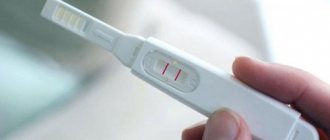How many days later should you take a pregnancy test?
To answer this question, it is important to understand how it works. Some time after conception, a woman’s body significantly increases the production of the “pregnancy hormone” - hCG (human chorionic gonadotropin). The test contains a special substance that reacts to the presence of hCG and colors the strip. Actually, everything is logical and simple: enough hCG in the urine - there will be two stripes.
HCG levels do not begin to rise immediately after intercourse. Even when the sperm meets the egg and fertilization occurs, the concentration of the hormone does not change in any way. Therefore, a pregnancy test taken the morning after sex will be negative. The increase in hCG production begins only after the fertilized egg attaches to the wall of the uterus. This happens 6–10 days after sex and conception. In the first days, the increase in hCG levels will be insignificant, then everything depends on the sensitivity of the test.
- The most common rapid tests are “tuned” to a sensitivity of 25 mIU/ml. This level of hCG is achieved only a couple of weeks after fertilization, which means that a pregnancy test can be taken 1-2 days after the delay. In the first days, you will need to wait a little while the reaction occurs and the strip turns color. Over the next few days, the concentration of hCG will skyrocket, and most tests will show a positive result almost immediately after entering the urine.
- You can ask your pharmacy for early pregnancy tests. They have a sensitivity of only 10 mIU/ml, thanks to which they are able to show results even before the delay, 3-4 days before the predicted start of the menstrual cycle.
December 24, 2017
There are two lines on the test, but there is no pregnancy: does this happen?
The onset of pregnancy can be either a long-awaited or a very unexpected event in the life of a woman or family. At the moment when a woman begins to suspect her “interesting situation” or cannot associate the appearance of new characteristic symptoms with anything else, a pregnancy test comes to the rescue. This simple, but at the same time very convenient invention “works” quite accurately. The probability of an erroneous result if the test is carried out in a timely manner does not exceed 1%. Moreover, the test can be both false negative and false positive. Today we will talk about those situations when the test shows a positive answer, although the woman is not pregnant. Why does this happen sometimes?
How does a pregnancy test work?
To understand why a pregnancy test may show a false result, it is important to understand how it works. Before performing the test, you must read the instructions for use. The procedure is very simple: lower the test strip with a certain end into a container with urine or place it under a stream of urine, then evaluate the test after a specified time.
The appearance of two lines on the test will indicate a positive result, that is, an existing pregnancy. This is magic? Or how to explain such an amazing phenomenon that a narrow test strip can notify an expectant mother about the upcoming addition to the family before the doctor?
What is HCG?
No, there is no magic in a pregnancy test. Simple chemistry. The test strip contains a chemical indicator that reacts with human chorionic gonadotropin (hCG). This is one of the earliest pregnancy hormones, which is secreted by chorionic villi (the future placenta). Its release begins from the moment the fertilized egg attaches to the uterine wall and continues throughout the pregnancy. It can be detected in the blood or urine of the expectant mother. A pregnancy test is based specifically on the detection of hCG in the mother's urine.
It is recommended to carry out the test no earlier than the first day of the missed period or approximately two weeks from the expected day of conception if the woman has an irregular cycle.
Why are pregnancy tests false positive?
Women react differently to the two lines that appear on the test, because for some, pregnancy is a cherished dream, for others it is an unpleasant surprise. In any case, a positive test result is only the initial step in diagnosing pregnancy.
By the way, the test result is not always expressed by the number of stripes. Sometimes the signs “+” or “─” appear, sometimes the words “pregnant” or “not pregnant”, “Yes” or “No”. This does not change the essence of the matter, because any pregnancy test only reflects the amount of hCG in the urine of the test subject.
However, it happens that the test strip shows a positive result in the absence of pregnancy. Why? Let's look at the most common reasons for a false positive response during a pregnancy test.
Postpartum period
The level of hCG increases in the bloodstream and in the urine of the expectant mother from the first days of pregnancy, reaching its maximum in the third month of gestation (7-11 weeks). After reaching this period, the hormone level gradually decreases. However, the test remains positive throughout the entire period of pregnancy and even for some time after its end (on average 3 weeks).
That is, there is no need to panic if, after a recent birth, the test shows two stripes. This does not mean that the woman will soon become a mother again. It just takes time for the hCG levels to drop. However, we must not forget about reliable contraception even in the first months after childbirth, if the family does not plan to have similar children.
Recent miscarriage or abortion
After spontaneous termination of pregnancy (frozen pregnancy, miscarriage) or abortion, the hCG level also does not decrease immediately. This period can last from 9 to 35 days (on average about 3 weeks). Accordingly, a pregnancy test taken in a given time period may turn out to be positive if there is no embryo in the uterus at the time of the test. The test will take a particularly long time to be positive if there are remains of placental tissue in the uterine cavity.
If there is any doubt about the presence of pregnancy, a woman should donate blood to check the hCG level (this is not only a qualitative, but also a quantitative analysis) and/or have an ultrasound of the pelvic organs. This will allow you to understand whether there is a pregnancy, or whether the test reflects the presence of hCG from a pregnancy that was very recent.
Hydatidiform mole
Women know very little about this disease or have never even heard of it, but obstetrician-gynecologists are very afraid of it. What is a hydatidiform mole? This is one of the most serious pathologies of pregnancy, in which the chorionic villi (placenta) change pathologically. Young women are more likely to get sick. The causes of this condition have not yet been fully established.
With hydatidiform mole, bubble-like expansions are formed along the chorionic villi. There are different forms of hydatidiform mole. Normal development of the fetus with this development of events is in most cases impossible, it dies. The disease itself is very serious and can even threaten the patient’s life. Removing a hydatidiform mole is the only way to treat a woman.
A pregnancy test during the development of a hydatidiform mole is always positive. Even the uterus increases in size because the chorionic villi grow like bunches of grapes. Ultrasound examination of the uterus is of decisive importance in the diagnosis of hydatidiform mole.
Chorionepithelioma (chorionic carcinoma)
This is a malignant tumor of the trophoblast (that is, the chorionic villi or placenta). Chorionepithelioma can be a consequence of hydatidiform mole, as well as an independent disease. It happens both in pregnant women and in women in the postpartum period.
The tumor quickly metastasizes, forming foci in various internal organs. Since the tumor is based on trophoblast tissue, a large amount of hCG is produced, as a result of which the pregnancy test will be positive. The disease is very serious, the prognosis is serious.
Superovulation in preparation for IVF
Some women dream of having a baby so much that they take pregnancy tests even when they are not needed, for example, when preparing for in vitro fertilization (IVF). During the period of taking medications for superovulation, a large amount of hCG is produced in the ovaries, which will certainly be shown by a positive test result, although pregnancy is still far away. Doctors should inform the patient about this in advance so that she does not make hasty conclusions that she was able to get pregnant on her own.
Tumors of internal organs
All of the above reasons for a false-positive pregnancy test are still related to pregnancy, even one that has recently ended or has not yet occurred. But it also happens that a positive test has nothing to do with pregnancy. We are talking about tumor processes in internal organs, in which the tumor produces hCG. This happens with tumors of the ovaries, brain, lung, stomach, breast cancer, etc.
As a rule, a woman finds out about existing malignant tumors in other ways, and not through a positive pregnancy test. Still, a pregnancy test is usually done when menstruation is late, while cycle failure in the presence of tumors is not at all necessary.
Technical violations during the test
It very rarely happens that a woman has a low-quality test in her hands, which gives a false positive result. However, knowing that this happens, many women deliberately take several pregnancy tests from different companies. Repeated test failure is unlikely. In addition, when conducting the test, you must strictly record the time allotted for interpreting the result. Usually it is 3-5 minutes.
By the way, it’s not bad if the test is also evaluated by another person (girlfriend, spouse). It happens that a woman simply imagines the desired stripe, while in reality it is not there.
What to do if you have doubts about a pregnancy test?
It happens that a woman doubts the correctness of the test. For example, the test shows a positive answer, although there are no other signs of pregnancy. Or there is menstrual-like discharge, although the test indicates pregnancy. Or in a situation where two tests showed different results? What to do?
- First: there is no need to try to find the truth on your own. The most correct thing is to consult an obstetrician-gynecologist. It is he who will decide what needs to be done first: donate blood from a vein for hCG, do an ultrasound of the uterus and ovaries, or simply examine the patient in a chair.
- Second: do not try to get rid of pregnancy (which has not yet been confirmed) in out-of-hospital conditions. Frightened by an unplanned pregnancy, some women resort to criminal abortions or simply take the “needed pill” at home. This is fraught with serious complications for life and health. The pregnancy must first be confirmed, and then the issue must be decided together with the doctor about how to terminate it, if such a desire arises.
- Third: try to “get to the bottom” of the truth. Lack of pregnancy is not a reason to relax. We need to find the reason why the test became positive. In some cases, the reason lies in serious cancer and endocrine disorders, which require not only diagnosis, but also timely treatment.
← Back
What time to take a pregnancy test?
If a woman is “deeply pregnant”, it doesn’t matter what time of day it is done - it will instantly show a positive result. However, at the very beginning of pregnancy, it is necessary to take into account daily fluctuations in hCG levels. The maximum concentration of the hormone is reached in the first half of the day, then falls. This is why a pregnancy test must be done in the morning. During the day and evening, you may get a false result due to a drop in the hCG content in the urine.
Another factor that can ruin the test is urine that is too “diluted.” You shouldn’t put too much work on your kidneys, i.e. Drink plenty of fluids or take diuretics before the test.
There is no pregnancy, but the test is positive
Sometimes rapid pregnancy tests show a positive result even if there is no pregnancy. Why is this happening?
- For some period after a miscarriage or abortion.
- After surgery due to an ectopic pregnancy.
- For a tumor that produces hCG release (chorionepithelioma).
- Growth of placental villi in the absence of an embryo (hydatidiform mole).
- Taking medications containing hCG (for the pregnancy test to be informative, you need to take a 10-day break).
What types of pregnancy tests are there?
They all work on the principle of determining the concentration of hCG in urine - there are no other options. As we have already said, they differ in what day the pregnancy test is taken, i.e. sensitivity. In addition, they have differences in design. Let's look at what types are available for sale.
Strip test
This is the simplest option, which is a strip of paper with a mark applied, to which it must be immersed in a container with urine. The advantages of the strip test include the fact that it is the cheapest of all, the disadvantages are the need to aim at the jar and a complex usage pattern compared to others. The strip must be immersed in urine strictly to a certain level and kept in it no less and no more than the time specified in the instructions. A small error can lead to a false result.
Test cassette
Cassettes (sometimes called “plate tests”) are strip tests in convenient packaging. When conducting such a study, a jar is not used, and nothing needs to be immersed anywhere. It comes with a pipette, from which you need to drop a couple of drops of urine into a special window and wait for the result. Despite the fact that there is a regular test strip inside the cassette, this scheme of action significantly reduces the likelihood of error.
Jet test
As the name implies, the test must be placed under a stream of urine. This is its main advantage: due to the fact that it does not require any auxiliary devices, it is very easy to use. However, you always have to pay more for convenience: the disadvantages of the method include a higher price.
Electronic test
An electronic test is the highest level of comfort in determining pregnancy. Like the jet one, it needs to be placed under a stream of urine, but you don’t have to look closely at the stripes. The test itself will write “pregnant” or “not pregnant” on the screen. Some models can even show how many weeks have passed since conception - just like a real laboratory study. This method, perhaps, has almost no disadvantages, if you do not take into account the highest cost of all.
Frautest Planning
The package contains 5 ovulation tests, 2 pregnancy tests and 7 urine containers. This is an excellent kit for those who are planning a pregnancy and are actively working on it. Frautest Planning is one of the most accurate pregnancy tests from the Hungarian. Thanks to such a “rich” set, you can not only “catch” the day of ovulation, but also determine pregnancy. Moreover, Frautest Planning can be used as early as two days before the expected delay. The included disposable urine containers can be used not only at home, but are easy to recycle. One disadvantage of this pregnancy test is the high price. But if you calculate how much everything will cost separately, then the cost of the kit is quite justified. This test will be appreciated by those women who are planning a pregnancy.
Frautest Planning
Test strips impregnated with reagent (labeled antibodies to LH to determine ovulation, labeled antibodies to hCG to determine pregnancy).
from 461
5.0 1 review
41
- Like
- Write a review
How to take a pregnancy test correctly?
You will find exact information about this in the instructions for the express test; each of them may be slightly different. When carried out correctly, they provide a very high level of reliability - almost the same as testing blood in a laboratory. In most cases, the wrong result is obtained due to trivial errors, and here are the most common ones:
- The test was done too early. Doing it immediately after conception is completely pointless. Tests with standard sensitivity work starting from the first day of the delay, more accurate ones - 3-4 days before.
- The test was carried out in the afternoon or evening. At the beginning of pregnancy, when the concentration of hCG during the day may become too low, it should be done in the morning.
- There is a lot of water in the urine. Don't drink a lot of fluids the night before the test and don't take diuretics.
- The expiration date has expired. If the test is expired, it may give a false negative result. Be sure to check the expiration date before use.
There are other factors that can cause an incorrect result, such as ectopic pregnancy, tumors and other diseases4. Therefore, remember: a pregnancy test is not the ultimate truth, but just a reason to see your doctor. Only he can finally confirm that the joyful event has happened!
Blood test for hCG
In addition to home tests, doctors recommend taking a blood test. It is more informative, since the concentration of the hormone in the blood is several times higher than in the urine. The test can detect pregnancy earlier than urine tests, but it takes longer to complete.
There are 2 main types of blood tests for hCG:
- qualitative. Answers the question: is the hormone level elevated or not, which indirectly suggests the presence or absence of pregnancy in a woman;
- quantitative (beta-hCG). This analysis reflects the exact concentration of the substance in the blood, so the doctor can monitor hormonal changes over time.
To obtain correct blood test results, you must adhere to the following rules:
- the analysis is performed strictly on an empty stomach in the morning;
- 12 hours before the test, alcohol consumption, physical activity, and smoking should be completely avoided;
- In the morning on the day of analysis, drinking water is allowed;
- It is necessary to avoid taking any medications. If this is not possible, you need to notify the laboratory and doctor.
Determining pregnancy is not the only task of a blood test for hCG. As noted earlier, during the formation and development of the embryo, the level of the hormone in a woman’s body should gradually increase - up to the 12-13th week of pregnancy. If, with regular observation, an increase in hCG is not observed or the hormone level does not correspond to generally accepted standard values for a specific period, then this may indicate the development of a frozen or ectopic pregnancy, with a high probability of miscarriage.
At later stages, quantitative determination of hCG can be used as a screening for genetic disorders in the fetus (Down or Edwards syndrome). The determination of beta-hCG also plays an important role. If a woman’s level of this hormone is elevated, but other characteristic signs of pregnancy are not observed, tumor diseases should be suspected.
Blood sugar levels
lThe normal blood sugar level for an adult is:
- 3.3–5.5 mmol/l (when collecting capillary blood)
- 3.7–6.1 mmol/l (at sampling)
If the level is exceeded above 6.1 mmol/l, it is necessary to be examined.
In order for your results to be reliable, you need proper preparation for the sugar test.
Principle of operation
First, let's briefly talk about the principles on which these tests are based. A woman's urine is used to determine pregnancy. With the onset of pregnancy, the body begins to produce a special hormone - human chorionic gonadotropin. With each day of pregnancy, its concentration in the urine increases and, starting from a certain point, its presence can be determined using a pregnancy test. In any test there is a reagent that comes into contact with this hormone and signals this to the user.
There are several types of tests:
- test strips,
- tablets,
- inkjet,
- reusable electronic.
Types of tests, advantages and disadvantages
| test name | advantages of the test | test shortcomings |
| test strip | low price, ease of use | high probability of making a mistake, low information content, often obtaining ambiguous results, short time to demonstrate the result |
| tablet test | protection from wetting strips, simplicity | high price |
| jet test | the greatest ease of use, the ability to do without utensils, high sensitivity | high price |
| electronic test | high information content, high sensitivity, ability to connect to a computer | complexity, high price |
The tests have different sensitivity - from 10 units to 30. The lower the index, the more sensitive the pregnancy test. The most sensitive testing systems can detect pregnancy as early as 10 days after ovulation—several days earlier than tests with low sensitivity. Typically, the more expensive and complex the test, the higher its sensitivity. Most test strips have low sensitivity, but electronic systems have high sensitivity.
Evitest Proof
This pregnancy test has a tablet design, thanks to which urine is evenly distributed over the substrate with the reagent (and this ensures the most accurate result). An important point is the impossibility of sample contamination, which also increases efficiency. The reagent is located in the window, so it cannot even be touched accidentally. The disadvantage of the Evitest Proof test is that it is most convenient to carry out at home. Otherwise, this is an excellent option if you need to determine as accurately as possible the presence or absence of pregnancy.
Evitest Proof
Pregnancy test EVITEST is a one-stage diagnostic hCG test - a test for quickly determining pregnancy in the early stages, based on the content of hCG hormones in a urine sample.
EVITEST helps solve such an important problem for a modern woman as early diagnosis of pregnancy. from 215
5.0 1 review
36
- Like
- Write a review
Frautest Express Ultra sensitive
This pregnancy test is very sensitive, so it can be used even before your missed period. The result is within 3-5 minutes after removal from the container with urine. Among the disadvantages of the Frautest Express test is the need to find the right container for collecting urine, so it is convenient to do it only at home. The undoubted advantages are 99% reliability of the result, high sensitivity to hCG and an affordable price.
Frautest Express Ultra sensitive
FRAUTEST Express - Test strip for determining pregnancy.
It is a paper strip impregnated with a reagent (labeled antibodies to hCG) on a plastic substrate, which is immersed in a container with the urine being tested. from 75
5.0 1 review
50
- Like
- Write a review
ClearBlue Digital
This is a digital pregnancy test, the accuracy of which is above 99%. This is a very high figure, which is why digital tests are currently considered the best in all respects. In addition, ClearBlue Digital can be used to determine the gestational age in weeks. That is, if there is “+” in the window, then the period range will also be displayed on the screen (1-2, 2-3 and more than 3 weeks). Impressive, right? A pregnancy test can be used not only from the first day of a missed period, but also 4 days before the delay. The only drawback of the ClearBlue Digital test is its high cost. And considering that not every woman needs information about the duration of pregnancy, but only about its presence/absence, you need to think before purchasing such a test.
Clearblue Digital
SPD Swiss Precision Diagnostics GmbH, Switzerland
Electronic pregnancy test Clearblue Digital
from 454
284
- Like
- Write a review
Premium Diagnostics
This inkjet pregnancy test is highly accurate (up to 99%) if performed from the first day of your missed period. You don't need a container to catch urine, so this is a great option for outdoor use. The Premium Diagnostics test has a special control window: if the test is done correctly, a red stripe will appear in it (regardless of whether the result is positive or negative). In our opinion, this is an excellent test: high sensitivity plus no connection to home conditions. What else is needed.
Premium Diagnostics
Premium Diagnostics, Germany
Pregnancy test for the diagnosis and determination of human chorionic gonadotropin (HCG) in urine.
from 84
5.0 1 review
26
- Like
- Write a review
Indications for analysis
Symptoms that may be caused by low blood sugar:
- constant lethargy, fatigue;
- increased sweating;
- anxiety;
- attacks of hunger.
Symptoms that high sugar levels can cause:
- rapid breathing;
- dry mouth, thirst;
- dry skin;
- decreased clarity of vision;
- frequent urge to urinate;
- poor wound healing;
- itching of the skin and mucous membranes;
- weight loss.
If you notice some of the listed symptoms, make an appointment with a general practitioner, he will conduct a diagnosis and write a referral for the necessary analysis.
With both deviations from the norm, an unstable mental state and mood swings may be observed.








